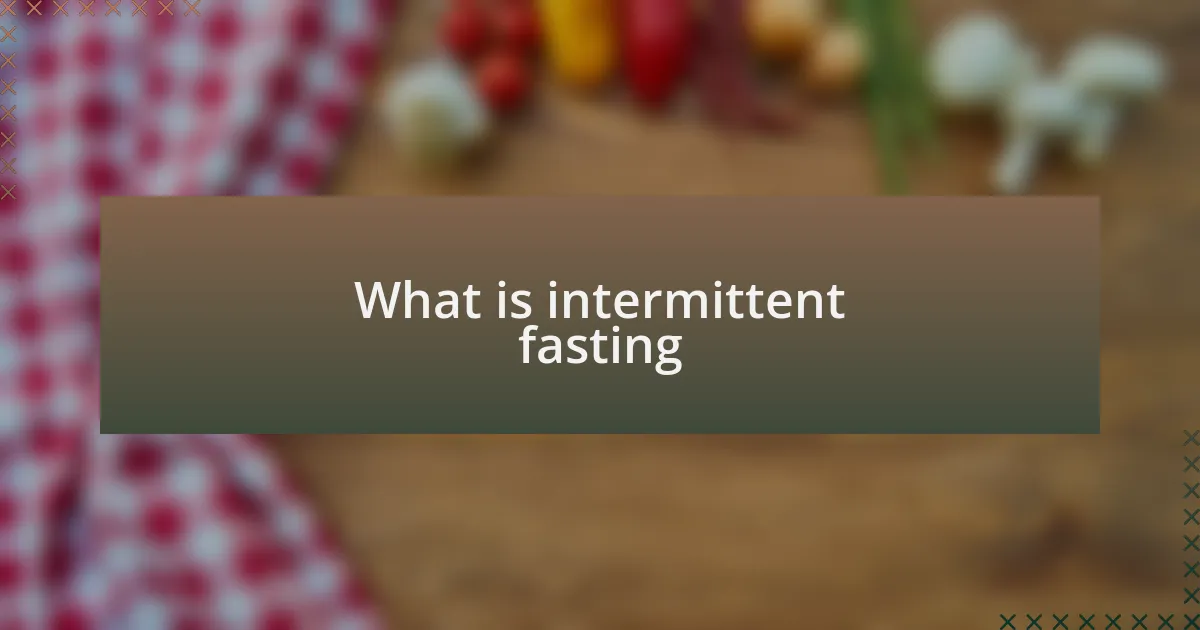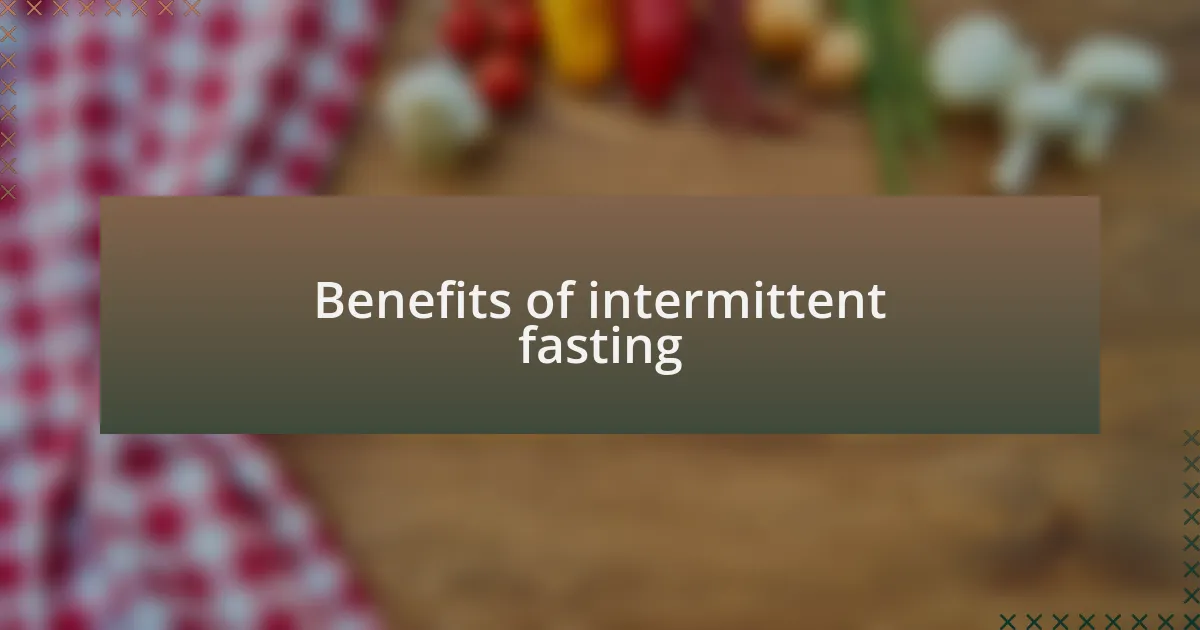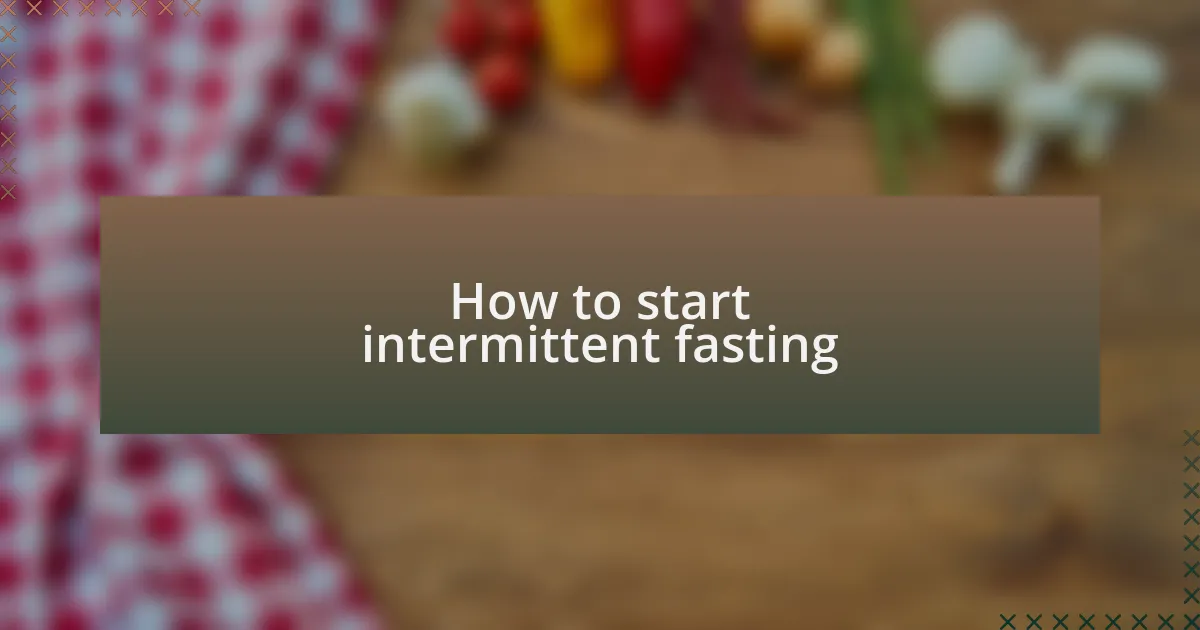Key takeaways:
- Healthy eating is about nourishing the body and being mindful of hunger signals rather than just counting calories.
- Intermittent fasting emphasizes when to eat, potentially enhancing mental clarity, promoting weight loss, and improving health markers.
- Choosing a flexible fasting method, like 16/8, and gradually adjusting eating habits can make the transition easier and more fulfilling.
- Staying hydrated and meal planning are crucial for a successful fasting experience, along with listening to your body’s true hunger cues.

Understanding healthy eating habits
Healthy eating habits are about more than just the food on your plate; they encompass the choices we make and the mindset we adopt toward nutrition. I remember the pivotal moment when I first understood that it wasn’t just about counting calories but about nourishing my body with wholesome foods. Have you ever felt the difference between eating out of obligation versus enjoyment?
I’ve found that listening to one’s body is crucial in establishing these habits. There were times when I mindlessly munched on snacks while watching TV, not realizing how disconnected I was from my own hunger cues. It made me reflect: how often do we ignore our body’s signals in our busy lives?
In a world full of fast food and quick fixes, I truly cherish the moments spent preparing a meal with fresh ingredients. Cooking can be a therapeutic process, and it allows me to explore flavors and textures that contribute to a healthier lifestyle. What dishes do you enjoy making that make you feel good inside? It’s a simple yet profound way to foster a positive relationship with food.

What is intermittent fasting
Intermittent fasting is a dietary approach that alternates between periods of eating and fasting. I remember the first time I tried it; I felt a mix of curiosity and apprehension about not eating during specific hours. It’s fascinating how our bodies can adapt to different eating patterns, allowing us to tap into our natural rhythms.
In essence, it’s not so much about what you eat but when you eat. The simplicity of this method appealed to me, as it removed the stress of meal planning throughout the day. Have you ever considered the mental clarity that can come from having structured eating windows? I found that my focus improved, and my cravings were more manageable during fasts, which enhanced my overall relationship with food.
Different styles of intermittent fasting exist, such as the 16/8 method, where you fast for 16 hours and eat for 8 hours. This not only helped me establish a routine but also sparked a deeper awareness of my hunger. As I explored this method further, it prompted me to ask: what if we could harness our body’s natural hunger signals instead of constantly snacking? The shift in mindset was profound; it transformed my approach to meals from mindless eating to intentional nourishment.

Benefits of intermittent fasting
One significant benefit I’ve experienced with intermittent fasting is enhanced mental clarity. I remember those initial fasting hours where my mind felt unusually sharp, unfettered by the usual post-lunch sluggishness. Have you ever noticed how you can think more clearly when distractions—like constant snacking—are eliminated? It truly highlights the power of giving your brain a break from constant food intake.
Beyond clarity, intermittent fasting has been linked to weight loss and improved metabolism. I’ve seen firsthand how the body can efficiently switch from burning glucose to tapping into fat reserves. Isn’t it interesting how our bodies are designed to adapt? This metabolic shift not only supports weight management but can also foster a deeper connection with our body’s natural hunger signals.
Another profound benefit I’ve found is the potential for improved health markers, such as lower blood sugar levels and reduced inflammation. When I began my intermittent fasting journey, I was pleasantly surprised to discover positive changes during my routine check-ups. How incredible is it to think that something as simple as adjusting my eating windows could have such a significant impact on my health? These results have motivated me to continue exploring this approach, reinforcing my belief in its power.

How to start intermittent fasting
When starting intermittent fasting, it’s important to choose a method that fits your lifestyle. Personally, I found the 16/8 method, where I fast for 16 hours and eat during an 8-hour window, to be the most manageable. Have you ever felt overwhelmed by strict dieting rules? This approach allows for flexible eating without feeling overly restricted.
I recommend beginning with a gradual shift to ease into the practice. Initially, I would skip breakfast and push my first meal to noon, which took some adjustment but felt empowering. How often do we allow our schedules to dictate our eating habits? By taking control of my eating windows, I started to appreciate the act of eating more.
Listening to your body is crucial in this journey. I’ve learned to recognize my hunger cues and understand when I genuinely need to eat versus when I’m grazing out of habit. Does it surprise you how often we eat simply out of boredom? By focusing on intentional eating during my feeding window, I’ve cultivated a more mindful relationship with food.

My personal experience with fasting
Fasting became a journey of self-discovery for me. I still remember the first day I decided to try it; I felt a mix of excitement and apprehension. It was intriguing to notice how my body reacted to the absence of food. Did I really need to eat every few hours as I had always thought? The clarity I experienced during that fast surprised me.
As I embraced intermittent fasting, I found moments of connection with my surroundings that I had previously overlooked. One afternoon, while sipping herbal tea during my fast, I noticed how much more I appreciated the flavors and aromas. Have you ever had a moment where everything seems to slow down? It was eye-opening to realize that my fasting period wasn’t just about abstaining from food; it became a time for reflection and mindfulness.
Over time, I faced my fair share of challenges. I remember a particularly busy day when I felt the temptation to snack while working. Instead, I chose to stick to my fasting window, and it felt rewarding to acknowledge my resolve. How often do we underestimate our willpower? This practice not only strengthened my self-discipline but also revealed the joys of patience and delayed gratification, offering me a new perspective on hunger itself.

Tips for successful intermittent fasting
Staying hydrated is vital during intermittent fasting, and I learned this the hard way. I once neglected to drink enough water, thinking that fasting meant cutting out everything but the essential food. That day was tough! Now, I embrace hydration as a lifeline, often sipping on herbal teas or flavored water to stave off hunger pangs and keep my energy up. Do you ever forget to drink enough? I certainly did.
One strategy that works wonders for me is to plan my meals ahead of time. I was caught off guard on a busy workday, and I blindly reached for whatever snack was nearby instead of sticking to my planned meals. This experience taught me that having healthy meals prepped and ready to go not only supports my fasting schedule but also ensures I make nutritious choices. How can you prioritize your meal prep to make fasting more manageable?
Listening to your body is crucial, and I cannot stress this enough. There were times when I felt an overwhelming craving and nearly broke my fast, only to realize I was actually thirsty or simply tired. It’s about striking that balance and being mindful of what my body truly needs. Have you ever mistaken thirst for hunger? By tuning into those signals, I’ve become more attuned to my body’s rhythms, making fasting a more insightful experience.